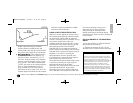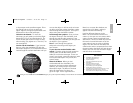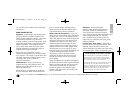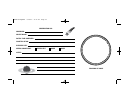
exposure. f/5 is faster than f/10. The faster
the ratio, the faster exposure time is
needed when a camera is hooked up to the
telescope. Your telescope has slower focal
ratio at f/8.8. Sometimes, astronomers use
focal reducers to make slow exposure
telescopes have faster focal ratios.
USE THE SPECIFICATIONS TO CALCULATE
THE MAGNIFICATION OF YOUR EYEPIECE
The power of a telescope is how much it
magnifies objects. Your 25mm eyepiece
magnifies an object 28 times. Your 9mm
eyepiece magnifies objects 78 times.
But if you obtain other eyepieces, you can
calculate how much magnification they
have with your telescope. Just divide the
focal length of the telescope by the focal
length of the eyepiece.
Focal Length of the Telescope
÷
Focal Length of the Eyepiece
=
Magnification
Look at the specifications. You will see that
the focal length of your scope is 1000mm.
Let’s say that you have obtained a 13mm
eyepiece. You can tell that what the focal
length of your eyepiece is as it is always
printed on the side of an eyepiece. Divide:
1000 ÷ 13, which equals 76.9. Round this off
to the nearest whole number and your new
eyepiece magnifies objects 77 times.
If you use a Barlow lens with one of your
eyepieces, it doubles the magnification of
your eyepiece. Other types of Barlows can
triple or further increase the power of an
eyepiece. To find out how much your
magnification is when you use a Barlow,
multiply your eyepiece’s magnification
by two.
Your 25mm low-power eyepiece magnifies
an object 28 times. Multiply 28 by 2 and you
get 56 times magnification with a Barlow.
Eyepiece’s magnification x 2
=
Magnification with a 2X Barlow lens
It’s worth repeating: Keep in mind that
a bright, clear, but smaller image is
more interesting than a larger,
dimmer, fuzzy one. Using too high a
power eyepiece is one of the most common
mistakes made by new astronomers. So
don’t think that higher magnification is
necessarily better—quite often the best
view is with lower magnification value!
TAKING CARE OF YOUR TELESCOPE
Your telescope is a precision optical
instrument designed for a lifetime of
rewarding viewing. It will rarely, if ever,
require factory servicing or maintenance.
Follow these guidelines to keep your
telescope in the best condition:
• As with any quality instrument, lens or
mirror surfaces should be cleaned as
infrequently as possible. Front surface
aluminized mirrors, in particular, should
be cleaned only when absolutely
necessary. In all cases avoid touching
any mirror surface. A little dust on the
surface of a mirror or lens causes
negligible loss of performance and
15
Looking at or near the Sun will cause irreversible damage to your eye. Do not point this telescope at or near the Sun. Do not look through the telescope as it is moving.
Meade114EQASTR 3/28/07 9:33 AM Page 17


















